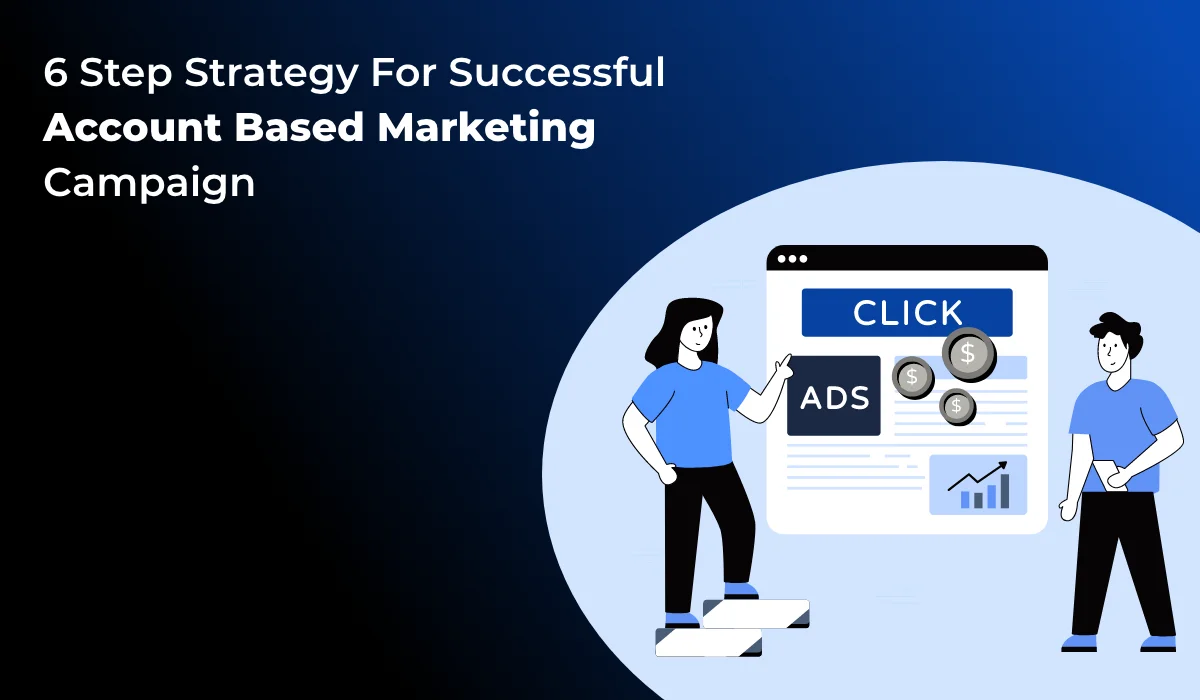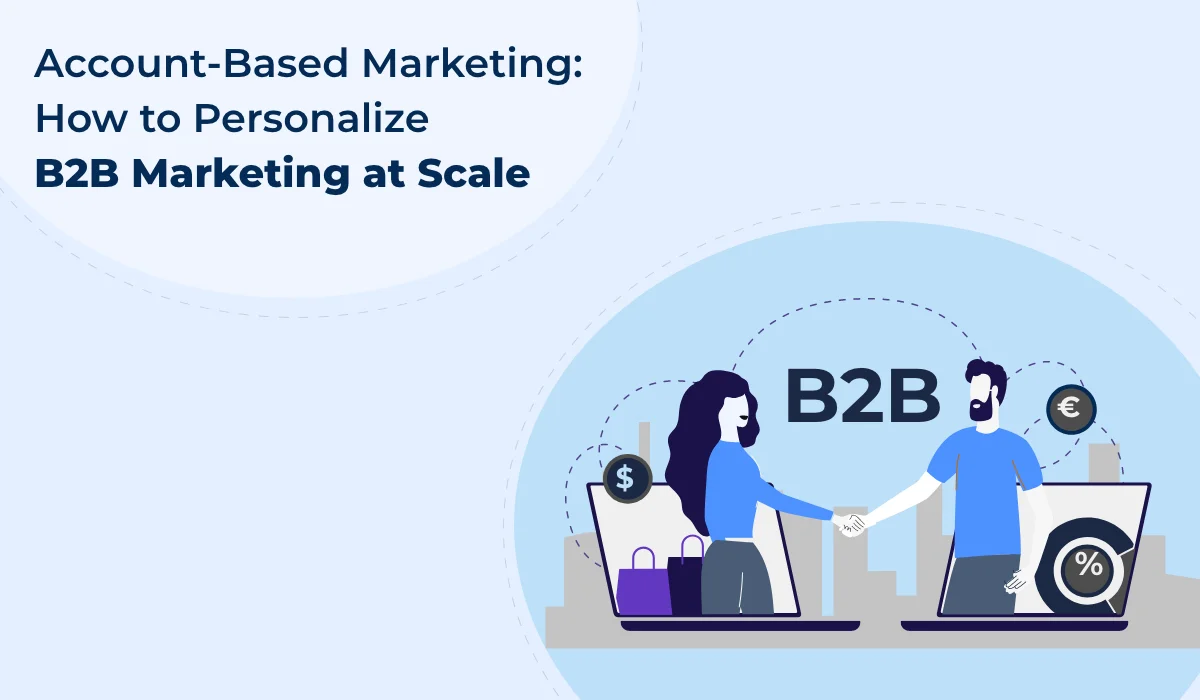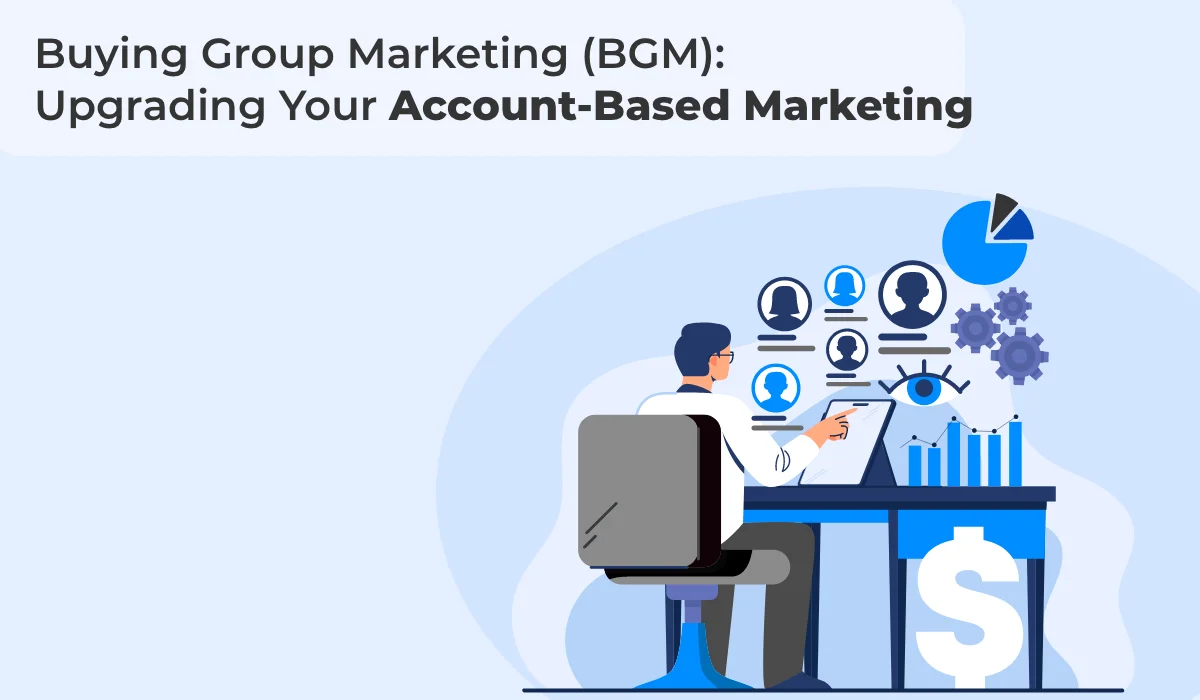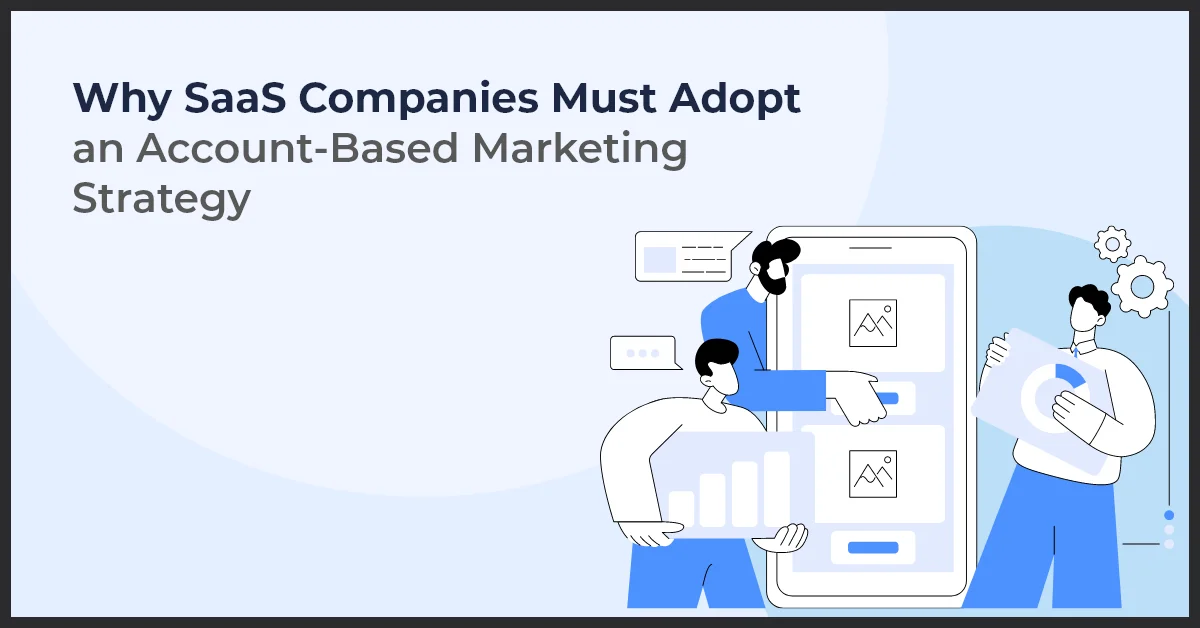6 Step Strategy For Successful Account Based Marketing Campaign

Published on: November 4, 2019
Updated on: September 04, 2024
3104 Views
- Account Based Marketing
9 min read
Unlocking Success with Account-Based Marketing Campaigns
Are you looking to boost your marketing efforts and achieve higher conversion rates? Enter Account-Based Marketing (ABM), a targeted strategy that has revolutionized the way businesses approach sales and marketing alignment. In this content, we will take you on a journey through the world of ABM, exploring its definition, advantages, and how it differs from traditional marketing strategies.
Account-Based Marketing (ABM) is a strategic approach in which marketing and sales teams collaborate to identify high-value target accounts and create personalized campaigns tailored expressly to engage and convert those accounts. Unlike traditional marketing strategies that focus on broad audience targeting, ABM laser-focuses on specific, pre-identified accounts, allowing for a more precise and customized approach.
The importance of implementing an ABM campaign lies in its ability to significantly increase ROI and revenue growth potential. By targeting key accounts that are more likely to convert, businesses can allocate their resources effectively, resulting in improved sales efficiency and higher customer acquisition rates. ABM also enhances marketing and sales alignment, fostering better collaboration and improving overall customer experience.
In contrast to traditional marketing strategies, ABM offers several unique benefits. Rather than casting a wide net and hoping for leads, ABM focuses on quality over quantity. By tailoring campaigns specifically to high-value accounts, ABM nurtures stronger relationships and engagement, leading to improved conversion rates. Additionally, ABM allows for precise measurement and analysis, enabling businesses to fine-tune and optimize their strategies continuously.
Our content plan will guide you through the stages of creating a successful ABM campaign. We will cover the essential components, from account selection and buyer persona identification to personalized content creation and measurement metrics. Get ready to elevate your marketing game and witness the transformative power of Account-Based Marketing.
If executed well, an Account-Based Marketing campaign could result in improved conversion rates for your top target accounts. Account-Based Marketing (ABM) is a strategic discipline that made its foray in the B2B world many decades ago. The irony is that many marketers are still struggling to develop successful account-based marketing campaigns.
According to a survey done by ITSMA, in 2013 the Investment in ABM was at an all-time high and was expected to rise in the coming years. With time there predictions have been proved correct, and as of now, 80% of marketers have started emphasizing ABM efforts.
ABM empowers B2B marketers to create more brand awareness and better engagement with their target list of accounts. Like any other business strategy ABM campaigns should also start with clear objectives and expected outcomes. Typical objectives you should consider are:
- Your expectation for qualified leads (Quantity and Quality)
- Average Revenue expectations per closed account
- Overall ROI from ABM campaign
- The right Budget for the ABM campaign?
Personalization and Customization in ABM Campaigns
Personalization and customization play a crucial role in the success of an Account Based Marketing (ABM) campaign. By tailoring messaging and content to specific accounts, marketers can create a personalized experience that resonates with the target audience.
Importance of personalized messaging and content in ABM campaigns
One of the key advantages of ABM is its ability to deliver personalized messages and content to individual accounts. Rather than taking a one-size-fits-all approach, ABM allows marketers to craft messages that are relevant and compelling to each specific account. This personalized approach helps to capture the attention of the target audience and increase engagement.
Techniques for tailoring messaging and content to specific accounts
There are various techniques that marketers can use to tailor messaging and content to specific accounts. One effective technique is conducting thorough research on the target account to understand their pain points, challenges, and goals. This research can then be used to create tailored messages that address their specific needs.
Utilizing data and insights to create personalized experiences
Data plays a crucial role in enabling personalization in ABM campaigns. By analyzing relevant data, marketers can gain insights into the preferences, behaviors, and buying patterns of their target accounts. This data can then be used to create personalized experiences that resonate with the specific account.
Case studies showcasing successful personalization and customization examples
There are numerous case studies that showcase successful examples of personalization and customization in ABM campaigns. These case studies highlight how companies have tailored their messaging and content to specific accounts, resulting in increased engagement, conversion rates, and revenue.
- Case Study 1: Company X increased conversion rates by 30% by tailoring messaging to each target account's pain points.
- Case Study 2: Company Y saw a 50% increase in revenue by delivering personalized content that aligned with each account's specific goals.
- Case Study 3: Company Z improved customer satisfaction by 20% through customized experiences that addressed individual account challenges.
Account Based Marketing Campaign Strategies: 6 Steps to Make it Successful
Some essential components should be appropriately incorporated to develop an effective ABM campaign. Here is the list of the same.
1. Identifying Target Accounts
The identification of target accounts is the most crucial part of any marketing campaign. Considering the right data makes you scientifically identify and pick up the accounts that possess a high likelihood of being your customers.
The essential data that you should consider to get more real company-level insights are:
- Firmographics to pick the right look and feel of your broad target companies
- Secondary Research to add a layer of intelligence to pick companies that are prime for your product or service
The firmographics analysis provides you broad company information, i.e., company size, industry, employee strength, revenue estimation, estimated growth, and graphical presence.
Secondary Research analysis reveals a deeper layer of intelligence. For example, if you are selling mobile app security software that is good for financial services companies the secondary research layer should help you identify Financial Services companies that have a Mobile App that is being widely used by its customers.
Considering data from this analysis will enable you to decide on the relevant accounts to pitch.
2. Building Account Centric Profiles
Now its time to get personalized with the particular people from the selected list of accounts for ABM. The objective of an Account-Based Marketing campaign is to build relationships with people, not with companies. Remember you may be targeting an account but at the end of the day, people in that account are going to make the purchase decision. You can explore LinkedIn to find out the people occupying the relevant roles in those companies. You can also invest in buying quality leads from list broker companies.
3. Developing Personalized Messages
Once you are done with collecting their contacts (emails or social media handles) next, you should build messaging that will resonate with the audience personas. The messaging should make them feel engaged and immediately makes sense to them.
Do proper homework before creating and building personalized messaging to these personas. You should research and know about their pain points, the current priorities, their needs, and their general buying behavior. After identifying their priorities, develop a straightforward content strategy to make them believe that you know what they need, and you can offer the best solution.
Psychology says buyers want to be treated like a human and your ABM targets are no different. In fact, referring to one recent Salesforce report, 72% of decision-makers in any business prefer personalized marketing instead of being treated as just another prospect in your marketing automation software.
4. Choosing The Right Mix of Channels
After identifying the accounts, target profile, and creating the right content, the next step is to present this content to them in a fitting way. For that, you need to choose a perfect blend of platforms through which you will target them. Inbound and outbound marketing channels need to be involved in this. Your ultimate aim is to get noticed by your prospects. So, try all traditional and creative options to get their attention.
Run multi-channel campaigns using phone, email, online advertising and publish your content across mediums that may be of interest to the target audience. To intensify these efforts, you could also sponsor and attend industry-specific events that you expect your target audience to attend.
Check out some Content Marketing Best Practices that will help you to deliver the right content to your ABM prospects through the right channel.
5. Aligning Sales & Marketing
The success of any marketing strategy is often calculated by the performance of actual sales. Running an Account Based Marketing campaign allows marketers to concentrate on particular people only. The ABM campaign activates sales and other revenue teams with account intelligence that aids in prioritizing the marketing qualified accounts. Moreover, it helps in 360-degree alignment in the sales & marketing departments. Here are some stats showing the benefits of ABM efforts.
- The B2B companies working on the ABM efforts; reported for having 200% more revenue than those who don’t.
- There are 67% higher chances of lead conversions and getting new clients.
- Along with higher sales companies experienced 36% higher customer retention; who have tightly aligned ABM efforts.
The entire ABM structure works around lead management that widens the scope of more conversions. Sales from ABM perspective concentrates on increased engagement, larger deals, and faster growth.
6. Measuring Success & Optimizing
Remember the objectives that you set at the initial stage? You should measure the performance of your Account-Based Marketing campaigns against those goals. Doing this will give you a clear picture of your current standing.
Check how many of those goals are achieved or how close you are to making those goals. Have a full-funnel approach. Check if your target audience is responding as expected if you are getting adequate qualified leads if your sales team is converting qualified leads and getting the desired sales results?
The beauty of playing with Account-Based Marketing campaigns is that your performance evaluation is much more precise as you're targeting a specific group of people within a target list of companies. And in case of not getting the expected results, it is easy to analyze and pinpoint the weak links of your plan.
In a nutshell, a successful ABM campaign demands company-wide collaboration and an in-depth study of your prospects. You should have a clear understanding of everything, your ABM goals, personas involved, challenges your prospects are facing and their preferred channels of engagement only then you can hit the bull's eye with your A Marketing efforts.
Well, it doesn't sound easy, but those who manage to pull it off the rewards are great. We can help you in creating perfect ABM strategy and manage your ABM campaign, write to us at info@growthnatives.com.



